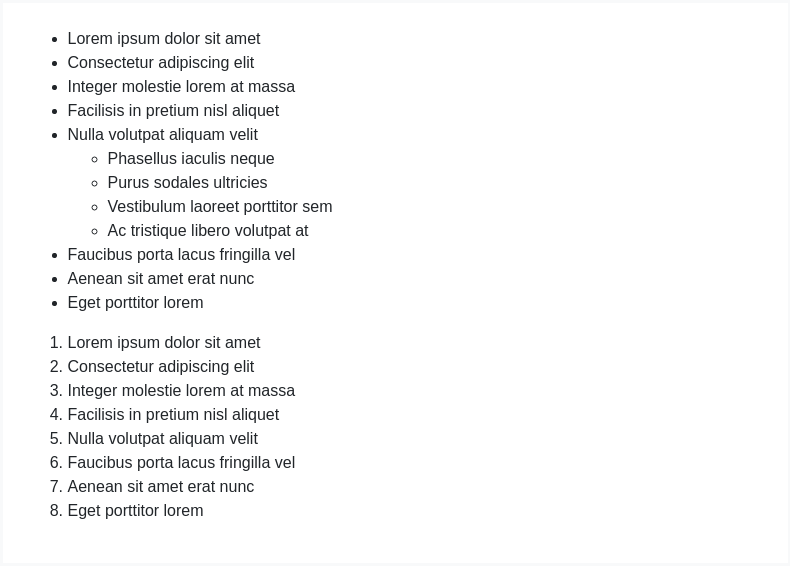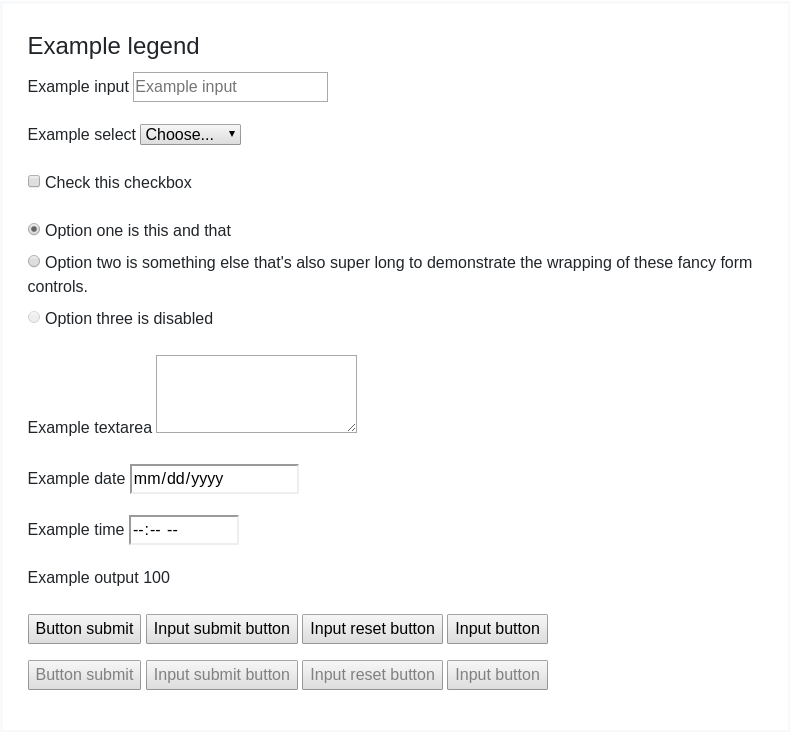- Reboot
- Approach
- Page defaults
- Native font stack
- Headings and paragraphs
- Lists
- Preformatted text
- Tables
- Forms
- Misc elements
- Address
- Blockquote
- Inline elements
- Summary
- HTML5 [hidden] attribute
- jQuery incompatibility
- jQuery incompatibility
Reboot
Reboot, a collection of element-specific CSS changes in a single file, kickstart Bootstrap to provide an elegant, consistent, and simple baseline to build upon.
Approach
Reboot builds upon Normalize, providing many HTML elements with somewhat opinionated styles using only element selectors. Additional styling is done only with classes. For example, we reboot some <table> styles for a simpler baseline and later provide .table, .table-bordered, and more.
Here are our guidelines and reasons for choosing what to override in Reboot:
- Update some browser default values to use
rems instead ofems for scalable component spacing. - Avoid
margin-top. Vertical margins can collapse, yielding unexpected results. More importantly though, a single direction ofmarginis a simpler mental model. - For easier scaling across device sizes, block elements should use
rems formargins. - Keep declarations of
font-related properties to a minimum, usinginheritwhenever possible.
Page defaults
The <html> and <body> elements are updated to provide better page-wide defaults. More specifically:
- The
box-sizingis globally set on every element—including::beforeand::after, toborder-box. This ensures that the declared width of element is never exceeded due to padding or border. - No base
font-sizeis declared on the<html>, but16pxis assumed (the browser default).font-size: 1remis applied on the<body>for easy responsive type-scaling via media queries while respecting user preferences and ensuring a more accessible approach. - The
<body>also sets a globalfont-family,line-height, andtext-align. This is inherited later by some form elements to prevent font inconsistencies. - For safety, the
<body>has a declaredbackground-color, defaulting to#fff.
Native font stack
The default web fonts (Helvetica Neue, Helvetica, and Arial) have been dropped in Bootstrap 4 and replaced with a “native font stack” for optimum text rendering on every device and OS. Read more about native font stacks in this Smashing Magazine article.
$font-family-sans-serif:// Safari for macOS and iOS (San Francisco)-apple-system,// Chrome < 56 for macOS (San Francisco)BlinkMacSystemFont,// Windows"Segoe UI",// Android"Roboto",// Basic web fallback"Helvetica Neue", Arial, sans-serif,// Emoji fonts"Apple Color Emoji", "Segoe UI Emoji", "Segoe UI Symbol" !default;
This font-family is applied to the <body> and automatically inherited globally throughout Bootstrap. To switch the global font-family, update $font-family-base and recompile Bootstrap.
Headings and paragraphs
All heading elements—e.g., <h1>—and <p> are reset to have their margin-top removed. Headings have margin-bottom: .5rem added and paragraphs margin-bottom: 1rem for easy spacing.
| Heading | Example |
|---|---|
<h1></h1> | h1. Bootstrap heading |
<h2></h2> | h2. Bootstrap heading |
<h3></h3> | h3. Bootstrap heading |
<h4></h4> | h4. Bootstrap heading |
<h5></h5> | h5. Bootstrap heading |
<h6></h6> | h6. Bootstrap heading |
Lists
All lists—<ul>, <ol>, and <dl>—have their margin-top removed and a margin-bottom: 1rem. Nested lists have no margin-bottom.

For simpler styling, clear hierarchy, and better spacing, description lists have updated margins. <dd>s reset margin-left to 0 and add margin-bottom: .5rem. <dt>s are bolded.

Preformatted text
The <pre> element is reset to remove its margin-top and use rem units for its margin-bottom.

Tables
Tables are slightly adjusted to style <caption>s, collapse borders, and ensure consistent text-align throughout. Additional changes for borders, padding, and more come with the .table class.

Forms
Various form elements have been rebooted for simpler base styles. Here are some of the most notable changes:
<fieldset>s have no borders, padding, or margin so they can be easily used as wrappers for individual inputs or groups of inputs.<legend>s, like fieldsets, have also been restyled to be displayed as a heading of sorts.<label>s are set todisplay: inline-blockto allowmarginto be applied.<input>s,<select>s,<textarea>s, and<button>s are mostly addressed by Normalize, but Reboot removes theirmarginand setsline-height: inherit, too.<textarea>s are modified to only be resizable vertically as horizontal resizing often “breaks” page layout.<button>s and<input>button elements havecursor: pointerwhen:not(:disabled).These changes, and more, are demonstrated below.

Misc elements
Address
The <address> element is updated to reset the browser default font-style from italic to normal. line-height is also now inherited, and margin-bottom: 1rem has been added. <address>s are for presenting contact information for the nearest ancestor (or an entire body of work). Preserve formatting by ending lines with <br>.

Blockquote
The default margin on blockquotes is 1em 40px, so we reset that to 0 0 1rem for something more consistent with other elements.

Inline elements
The <abbr> element receives basic styling to make it stand out amongst paragraph text.

Summary
The default cursor on summary is text, so we reset that to pointer to convey that the element can be interacted with by clicking on it.

HTML5 [hidden] attribute
HTML5 adds a new global attribute named [hidden], which is styled as display: none by default. Borrowing an idea from PureCSS, we improve upon this default by making [hidden] { display: none !important; } to help prevent its display from getting accidentally overridden. While [hidden] isn’t natively supported by IE10, the explicit declaration in our CSS gets around that problem.
<input type="text" hidden>
jQuery incompatibility
[hidden] is not compatible with jQuery’s $(…).hide() and $(…).show() methods. Therefore, we don’t currently especially endorse [hidden] over other techniques for managing the display of elements.
To merely toggle the visibility of an element, meaning its display is not modified and the element can still affect the flow of the document, use the .invisible class instead.
